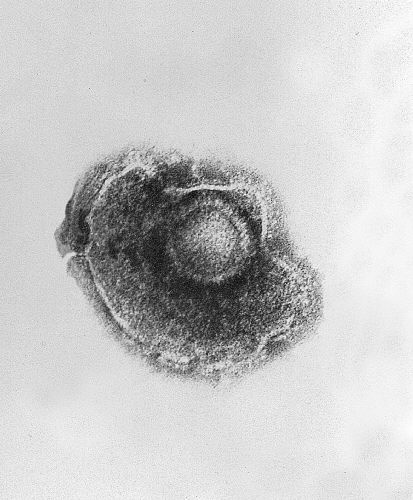Herpes zoster medical therapy
|
Herpes zoster Microchapters |
|
Diagnosis |
|---|
|
History and Symptoms |
|
Treatment |
|
Case Studies |
|
Herpes zoster medical therapy On the Web |
|
American Roentgen Ray Society Images of Herpes zoster medical therapy |
|
Risk calculators and risk factors for Herpes zoster medical therapy |
Editor-In-Chief: C. Michael Gibson, M.S., M.D. [1]; L. Katie Morrison, MD; Associate Editor(s)-In-Chief: Cafer Zorkun, M.D., Ph.D. [2]
Treatment


Currently, there is no cure available for Herpes zoster, nor a treatment to effectively eliminate the virus from the body. However, there are some treatments that can mitigate the length of the disease and alleviate certain side effects.
Antiviral drugs
Acyclovir (an antiviral drug) inhibits replication of the viral DNA, and is used both as prophylaxis (e.g., in patients with AIDS) and as therapy for herpes zoster. Other antivirals are valacyclovir and famciclovir. During the acute phase, oral acyclovir should be given. Use of acylovir is most effective in moderating the progress of the symptoms, and in preventing post-herpetic neuralgia, if started within 24 to 72 hours of the onset of symptoms, so medical care should be obtained as soon as the condition is recognized. Immunocompromised patients may respond best to intravenous acyclovir. In patients who are at high risk for recurrences, an oral dose of acyclovir, taken twice daily, is usually effective. It is also reported that the amino acid lysine inhibits the replication of herpes zoster.[1]
Other drugs
Cimetidine, a common component of over-the-counter heartburn medication, has been shown to lessen the severity of herpes zoster outbreaks in several different instances.[2][3][4] This usage is considered an off-label use of the drug. In addition, cimetidine and probenecid have been shown to reduce the renal clearance of aciclovir. [5] The study showed these compounds reduce the rate, but not the extent, at which valaciclovir is converted into aciclovir. Renal clearance of aciclovir was reduced by approximately 24% and 33% respectively. In addition, respective increases in the peak plasma concentration of acyclovir of 8% and 22% were observed. The authors concluded that these effects were "not expected to have clinical consequences regarding the safety of valaciclovir". Due to the tendency of aciclovir to precipitate in renal tubules, combining these drugs should only occur under the supervision of a physician.
Complementary Therapies
Digestive Enzymes are available on prescription and in some over the counter preparations. Before the availability of antivirals, oral pancreatic enzyme therapy in shingles was used in some countries and later subjected to clinical and scientific research. A large scale multi-centre clinical study, using an oral preparation of such enzymes, has shown promising results.[6] [7] The results of another clinical study support the concept that oral enzyme therapy is beneficial in diseases characterized in part by TGF-beta overproduction that included shingles patients. [8] TGF-β has also been found to be elevated in instances of VZV infection. [9] [10]
References
- ↑ Griffith, RS (1987). "Success of L-lysine therapy in frequently recurrent herpes simplex infection. Treatment and prophylaxis". Dermatologica. 175 (4): 183–190. PMID 3115841. Unknown parameter
|coauthors=ignored (help) - ↑ Kapinska-Mrowiecka M, &Toruwski G (1996.). "Efficacy of cimetidine in treatment of herpes zoster in the first 5 days from the moment of disease manifestation". Pol Tyg Lek. 51 (23–26): 338–339. PMID 9273526. Check date values in:
|year=(help) - ↑ Hayne ST, & Mercer JB (1983). "Herpes zoster: treatment with cemetidine". Canadian Medical Association Journal. 129 (12): 1284–1285. PMID 6652595.
- ↑ Notmann J, Arieli J, Hart J, Levinsky H, Halbrecht I, & Sendovsky U (1994). "In vitro cell-mediated immune reactions in herpes zoster patients treated with cimetidine". Asian Pacific Journal Allergy and Immunology. 12 (1): 51–58. PMID 7872992.
- ↑ De Bony F, Tod M, Bidault R, On NT, Posner J, & Rolan P (2002). "Multiple interactions of cimetidine and probenecid with valaciclovir and its metabolite acyclovir". Antimicrobial Agents and Chemotherapy. 46 (2): 458–463. PMID 11796358.
- ↑ Billigmann P (1995). "[Enzyme therapy--an alternative in treatment of herpes zoster. A controlled study of 192 patients]". Fortschr. Med. (in German). 113 (4): 43–8. PMID 7713467.
- ↑ Roxas M (2006). "Herpes zoster and postherpetic neuralgia: diagnosis and therapeutic considerations". Alternative medicine review : a journal of clinical therapeutic. 11 (2): 102–13. PMID 16813460.
- ↑ Desser L, Holomanova D, Zavadova E, Pavelka K, Mohr T, Herbacek I (2001). "Oral therapy with proteolytic enzymes decreases excessive TGF-beta levels in human blood". Cancer Chemother. Pharmacol. 47 Suppl: S10–5. PMID 11561866.
- ↑ Kaygusuz I, Gödekmerdan A, Keleş E; et al. (2004). "The role of viruses in idiopathic peripheral facial palsy and cellular immune response". American journal of otolaryngology. 25 (6): 401–6. PMID 15547808.
- ↑ Sato M, Abe T, Tamai M (2000). "Expression of the Varicella Zoster Virus Thymidine Kinase and Cytokines in Patients with Acute Retinal Necrosis Syndrome". 44 (6): 693. PMID 11094200.